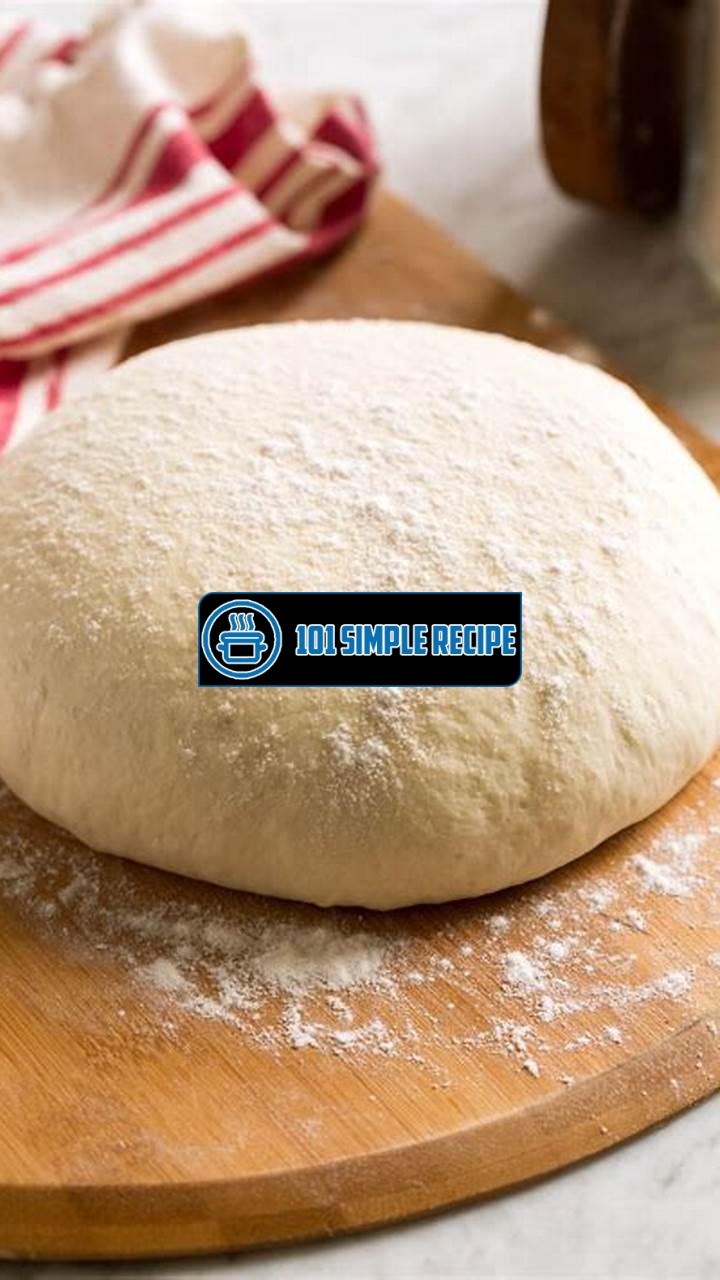Are you a pizza lover trying to perfect your homemade pizza? Look no further! ✨ In this article, we will teach you the art of making the perfect pizza dough using all-purpose flour. Whether you’re a seasoned home cook or a beginner in the kitchen, working with all-purpose flour makes the pizza dough-making process easy and accessible. With just a few simple tips and tricks, you’ll be able to create a delectable, customized pizza crust that rivals your favorite pizzerias’. So roll up your sleeves, gather your ingredients, and let’s get started on this doughy adventure!

The Science Behind Pizza Dough Recipe with All-Purpose Flour
When it comes to making the perfect pizza dough, using all-purpose flour can be a game-changer. This versatile ingredient plays a crucial role in creating a dough that is light, flavorful, and easy to work with. In this section, we will dive into the science behind using all-purpose flour in pizza dough and explore how it contributes to the overall texture and taste of the final product.
The Role of Flour in Pizza Dough
Flour is a key component in pizza dough as it provides structure, texture, and flavor. It contains proteins called gluten, which give the dough its elasticity and strength. When mixed with water, the gluten proteins form long strands that create a network, trapping air bubbles and giving the dough its characteristic chewiness. Additionally, flour acts as a thickening agent, absorbing moisture and binding the ingredients together.
When choosing the type of flour for your pizza dough, it’s important to consider its protein content. Higher protein flours, such as bread flour, produce a chewier crust, while lower protein flours, like all-purpose flour, yield a softer and more tender crust. The amount and type of flour used can significantly impact the final texture of your pizza dough.
The Benefits of Using All-Purpose Flour
All-purpose flour is a popular choice for pizza dough due to its versatility and accessibility. It is a blend of high-protein hard wheat and low-protein soft wheat, making it suitable for a wide range of baking applications, including pizza. Here are some key benefits of using all-purpose flour in your pizza dough:
- Availability: All-purpose flour is commonly found in most grocery stores, making it easy to obtain for home cooks.
- Consistency: All-purpose flour provides a consistent texture and quality to your pizza dough, ensuring reliable results with each use.
- Softness: The lower protein content of all-purpose flour leads to a softer and more tender crust, perfect for those who prefer a lighter bite.
- Versatility: All-purpose flour can be used in a variety of other recipes, such as bread, cakes, and pastries, making it a versatile staple in any kitchen.
The Differences Between All-Purpose Flour and Other Flours
While all-purpose flour is a go-to choice for many pizza dough recipes, it’s essential to understand the differences between all-purpose flour and other flours:
| Flour Type | Protein Content | Best for Pizza Dough? |
|---|---|---|
| Bread Flour | 12-14% | Yes, for a chewier crust |
| All-Purpose Flour | 9-12% | Yes, for a softer and more tender crust |
| Self-Rising Flour | Varies (includes leavening agents) | No, unless specifically called for in a recipe |
| Whole Wheat Flour | 14-16% | Yes, for a nuttier and heartier crust |
Take note: The protein content and type of flour you use can significantly influence the texture and flavor of your pizza dough. All-purpose flour is prized for its versatility and ability to produce a softer crust, but other flours may be preferred for specific taste preferences or dietary needs.
By mastering the art of pizza dough with all-purpose flour, you can create delicious homemade pizzas with the perfect balance of taste and texture. Experiment with different ratios of flour and other ingredients to find your ideal crust, and don’t be afraid to get creative with toppings and flavors. With all-purpose flour as your secret weapon, your pizza-making skills are bound to impress friends and family alike!
For a delicious twist, try this King Arthur pizza dough recipe that uses all-purpose flour.
Mastering the Art of Kneading
When it comes to making the perfect pizza dough, one of the most crucial steps is kneading. Kneading helps develop the gluten in the dough, giving it the ideal texture and consistency. Whether you’re a novice or an experienced baker, understanding the secrets of kneading will elevate your pizza-making game to a whole new level. So, let’s dive into the importance of kneading, the right techniques to use, and how to troubleshoot common kneading mistakes.
The Importance of Kneading in Pizza Dough Making
Kneading plays a vital role in pizza dough making. It helps distribute the ingredients evenly throughout the dough and activates the gluten proteins. Gluten is responsible for giving the dough its elasticity and structure. Without proper kneading, your pizza dough may turn out dense, tough, and lacking the desired chewiness.
Fun fact: Kneading is not only important for pizza dough but also for various other baked goods like bread and rolls. It’s a technique that has been used for centuries to create delightful and fluffy dough.
The Right Techniques for Kneading Pizza Dough
To master the technique of kneading pizza dough, there are a few key steps to follow:
- Preparation: Start by preparing a clean and lightly floured surface to work on. This will prevent the dough from sticking and make it easier to handle.
- Starting position: Place the dough on the floured surface and apply gentle pressure with the palms of your hands to flatten it slightly.
- Folding: Fold the dough in half towards you and use the heels of your hands to push it away from you. This motion helps stretch the gluten strands.
- Quarter turns: Give the dough a quarter turn and repeat the folding and pushing process. Continue this pattern for about 10-15 minutes or until the dough becomes smooth, soft, and elastic.
Remember to maintain a steady rhythm and not rush the process. The dough should feel slightly tacky but not sticky. If it’s too sticky, sprinkle a small amount of flour on the surface and incorporate it into the dough as you knead.
Troubleshooting Common Kneading Mistakes
Even with the right techniques, kneading mistakes can still happen. Here are some common issues and how to fix them:
| Mistake | Solution |
|---|---|
| The dough tears easily | It may lack sufficient gluten development. Continue kneading for a few more minutes to strengthen the gluten. |
| The dough is too dense | You may have over-kneaded the dough, causing the gluten to become too tight. In this case, let the dough rest for 10-15 minutes, then knead it lightly to relax the gluten. |
| The dough doesn’t rise properly | Insufficient kneading can prevent proper gluten development and fermentation. Ensure you knead the dough for an adequate amount of time to activate the yeast and allow it to rise. |
Pro tip: If you’re unsure about the dough’s readiness, perform the “windowpane test.” Take a small piece of the dough and gently stretch it with your fingers. If it forms a thin, translucent membrane without tearing, it’s ready for proofing.
By mastering the art of kneading, you’ll be able to create pizza dough with the perfect texture and consistency. Remember to be patient, follow the right techniques, and troubleshoot any potential kneading mistakes. With practice, you’ll be well on your way to becoming a pizza dough expert!
Rising to Greatness: Fermentation and Proofing
Dive into the science of fermentation and proofing to create a flavorful and airy pizza crust.
The Role of Yeast in Pizza Dough
When it comes to making delicious pizza dough with all-purpose flour, understanding the role of yeast is crucial. Yeast is a microscopic organism that plays a vital role in the fermentation process. It consumes sugar and produces carbon dioxide gas, which creates air pockets in the dough and gives it a light and airy texture.
To activate the yeast, you’ll need warm water and a small amount of sugar. This mixture provides the yeast with the necessary fuel to begin its fermentation process. The yeast feeds on the sugar and begins to multiply, creating carbon dioxide bubbles that cause the dough to rise.
Remember to use active dry yeast or instant yeast for pizza dough. These types of yeast are readily available and reliable for consistent results. After adding the yeast to the warm water and sugar mixture, let it sit for a few minutes until it becomes frothy. This indicates that the yeast is alive and ready to be incorporated into the dough.
The Fermentation Process: Time and Temperature
Once the yeast is activated and added to the flour, salt, and other ingredients, the fermentation process begins. This step is crucial as it allows the flavors in the dough to develop and improves its texture.
The duration of the fermentation process can vary depending on the recipe and desired outcome. In general, a longer fermentation time allows the dough to develop more complex flavors. Overnight fermentation in the refrigerator is common for achieving optimal taste and texture. This slow and cold fermentation process promotes the breakdown of proteins and starches, resulting in a more tender and flavorful crust.
Temperature plays a crucial role in fermentation. Warmer temperatures accelerate the fermentation process, while colder temperatures slow it down. For a quick pizza dough, you can let it ferment at room temperature for a couple of hours. However, if you have more time, allowing the dough to ferment in the refrigerator for 24-48 hours will produce a superior crust.
Optimizing Proofing Conditions for the Best Results
Proofing is the final stage in the process of creating the perfect pizza dough. During this step, the dough is left to rise after fermentation, allowing it to become soft, puffy, and full of flavor.
The proofing conditions can significantly impact the final result. The ideal environment for proofing is warm and draft-free. A temperature between 80°F and 85°F (27°C-29°C) is ideal for yeast activity and dough expansion. You can create a warm proofing environment by placing the dough in a lightly greased bowl, covering it with plastic wrap, and leaving it in a warm spot in your kitchen.
It’s essential to give the dough enough time to proof fully. A standard rule of thumb is to let it double in size. This can take anywhere from 1 to 2 hours, depending on the dough’s temperature and recipe.
Remember to gently punch down the dough after proofing to release excess gas and redistribute the yeast for a consistent texture. Now, your pizza dough is ready to be shaped, topped, and baked into a mouthwatering pizza masterpiece.
Secrets to Achieving a Perfect Crust
When it comes to making pizza dough with all-purpose flour, there are a few secrets and techniques that can help you achieve the perfect crust. Whether you prefer a crispy, chewy, or fluffy texture, these tips will guide you in creating a pizza dough that will impress your family and friends. So, let’s dive in and discover the tricks of the trade!
Adjusting Hydration Levels for Different Crust Textures
The level of hydration in your dough is crucial for achieving the desired crust texture. Hydration refers to the amount of water you incorporate into the dough during the mixing process. If you aim for a crispy crust, reduce the hydration slightly. On the other hand, if you prefer a chewy or fluffy crust, increase the hydration.
Tip: Experiment with different hydration levels to find the perfect balance for your taste preferences. Keep in mind that humidity and flour brands can affect the absorption of water, so adjust accordingly.
Baking Methods for Crispy, Chewy, or Fluffy Crusts
The way you bake your pizza plays a significant role in the final texture of the crust. Here are three baking methods to achieve your desired crust:
- Crispy: For a crispy crust, preheat your oven to its highest temperature, preferably with a pizza stone. Roll out your dough thinly and bake it directly on the stone for a short period of time. This method promotes fast heat transfer and creates a crispier crust.
- Chewy: To achieve a chewy crust, use a lower temperature setting (around 400°F / 205°C) and bake your pizza on a baking sheet. This slower baking process allows the dough to rise and develop a softer, chewier texture.
- Fluffy: If you prefer a fluffy crust, try the pan pizza method. Grease a deep-dish pan generously with oil and press the dough into it. Allow the dough to rise for a longer period of time (approximately 1-2 hours) to create air pockets, resulting in a light and airy crust.
Tip: Experimenting with different baking techniques and temperatures will help you find the perfect method for your desired crust texture.
Enhancing Flavor and Aesthetics with Toppings and Seasonings
Apart from achieving the perfect texture, you can enhance the flavor and aesthetics of your pizza dough by adding delicious toppings and seasonings. The possibilities are endless, so let your creativity run wild! Here are some ideas to get you started:
- Traditional Margherita: Top your pizza with fresh basil leaves, ripe tomatoes, and mozzarella cheese for a classic Italian flavor.
- Mediterranean Delight: Add kalamata olives, feta cheese, and sun-dried tomatoes for a taste of the Mediterranean.
- Spicy Kick: Sprinkle some crushed red pepper flakes or add slices of jalapenos for a spicy twist.
Tip: Don’t be afraid to experiment with different combinations of toppings and seasonings to find your signature pizza flavor.
Note: Remember to pre-cook ingredients like meat or vegetables that require more cooking time before adding them to your pizza. This will ensure that all the toppings and the crust are cooked to perfection.
By mastering the art of pizza dough with all-purpose flour, you can create your own homemade pizzas that rival those from the best pizzerias. With some experimentation and a sprinkle of creativity, you’ll be enjoying delicious pizzas with the perfect crust in no time. So roll up your sleeves, get your ingredients ready, and let’s make some mouthwatering pizza!
Unleashing Your Creativity: Unique Variations and Recipes
When it comes to making pizza dough with all-purpose flour, the possibilities are endless. With just a few simple ingredients, you can create a base that serves as a canvas for your culinary creativity. Whether you’re a fan of traditional pizzas or prefer to experiment with unique flavors, all-purpose flour can be your secret ingredient for delicious and versatile pizza dough.
One interesting variation to try is garlic and herb pizza dough. Simply mix in minced garlic, dried oregano, and dried basil to the flour before adding the other ingredients. This will infuse your dough with a savory aroma and add a burst of flavor to every bite.
For those who love a bit of spice, why not try a chili-infused pizza dough? You can add red pepper flakes or even diced jalapenos to your dough mixture for an extra kick. It’s a great option for those who like their pizza with a fiery twist.
If you’re a fan of Mediterranean flavors, consider incorporating sun-dried tomatoes and feta cheese into your pizza dough. This combination will transport your taste buds to the sunny shores of Greece and create a unique and memorable pizza experience.
For a touch of sweetness, try adding honey or maple syrup to your dough. The subtle hint of sweetness will complement savory toppings and add a delightful balance of flavors to your pizza.
Looking to take your pizza game to the next level? Experiment with toppings and fillings that go beyond the traditional. From pulled pork and barbecue sauce to smoked salmon and cream cheese, the possibilities are endless. Let your imagination run wild and create a truly one-of-a-kind pizza masterpiece.
Exploring Different Pizza Styles and Regional Specialties
Pizza is a universal favorite, but did you know that different regions have their own unique styles and specialties? By using all-purpose flour as your base, you can explore and recreate these styles right in your own kitchen. Here are some examples:
- Neapolitan Pizza: This style originated in Naples, Italy, and is known for its thin and soft crust. The high heat of a brick oven creates a chewy texture and crispy edges that are characteristic of Neapolitan pizza.
- Chicago Deep Dish Pizza: Contrary to the thin crust of Neapolitan pizza, Chicago deep dish pizza is all about the thick and buttery crust. The dough is pressed into a deep pan and layered with cheese, toppings, and sauce, resulting in a hearty and indulgent pizza experience.
- New York Style Pizza: New York-style pizza is famous for its large and foldable slices. The crust is thin and crisp on the outside, yet soft and chewy on the inside. It’s the perfect pizza for on-the-go munching.
- Sicilian Pizza: Sicilian pizza is characterized by its thick and fluffy square crust. It’s often topped with a rich tomato sauce, cheese, and various toppings. The dough is typically pillowy and light, making it a favorite among pizza lovers.
These are just a few examples of the countless pizza styles and regional specialties that you can create using all-purpose flour. Allow yourself to be inspired by different cuisines and let your pizza dough transport you to various parts of the world.
Vegetarian and Vegan Pizza Recipes with All-Purpose Flour
Vegetarian and vegan pizza lovers rejoice! All-purpose flour is a versatile ingredient that can cater to your dietary preferences. Here are some delicious vegetarian and vegan pizza recipes that you can whip up using all-purpose flour:
- Margherita Pizza: This classic Italian pizza is a vegetarian favorite. Simply top your dough with fresh tomatoes, mozzarella cheese, basil leaves, and a drizzle of olive oil for a simple yet flavorful pizza.
- Roasted Veggie Pizza: Load up your pizza with a variety of roasted vegetables such as bell peppers, zucchini, eggplant, and mushrooms. Sprinkle some vegan cheese on top and you have a colorful and nutritious meal.
- BBQ Jackfruit Pizza: Jackfruit is a popular meat substitute in vegan cooking, and it works incredibly well on pizza. Cook the jackfruit with barbecue sauce and use it as a topping along with onions and vegan cheese.
- Vegan Pesto Pizza: Swap out the traditional tomato sauce with a vibrant and flavorful pesto sauce. Top it with cherry tomatoes, olives, and vegan cheese for a burst of Mediterranean flavors.
These recipes prove that vegetarian and vegan pizzas can be just as delicious and satisfying as their meaty counterparts. Get creative with your toppings and don’t be afraid to experiment with different flavors and textures.
Gluten-Free Options and Substitutions for Pizza Dough
If you’re following a gluten-free diet, don’t worry – you can still enjoy pizza made with all-purpose flour. There are several gluten-free options and substitutions available that will allow you to indulge in this beloved dish. Here are a few suggestions:
- Gluten-Free Flour Blend: Look for gluten-free flour blends that are specifically designed for baking. These blends often contain a mix of alternative flours such as rice flour, tapioca flour, and potato starch.
- Almond Flour: Almond flour is a popular gluten-free flour that adds a nutty flavor to your pizza dough. It’s also high in protein and healthy fats, making it a nutritious choice.
- Cauliflower Crust: For a low-carb and gluten-free option, try making a pizza crust using cauliflower rice. Simply combine cooked cauliflower with eggs, cheese, and seasonings of your choice, then bake it into a crispy crust.
- Quinoa Flour: Quinoa flour is another great gluten-free alternative. It’s high in protein and adds a slightly nutty flavor to your pizza dough.
With these gluten-free options and substitutions, you can still enjoy a delicious pizza without worrying about the effects of gluten on your body. Experiment with different flours and find the one that suits your taste and dietary needs the best.
Frequently Asked Questions
Thank you for reading our article about pizza dough recipe with all-purpose flour. We hope you found it helpful and inspiring to make your own delicious homemade pizza. If you have any more questions, please refer to the FAQs below.
| No. | Questions | Answers |
|---|---|---|
| 1. | Can I use regular all-purpose flour for pizza dough? | Yes, you can use regular all-purpose flour for pizza dough. It will yield a slightly chewier crust compared to using pizza flour or bread flour, but it still works well. |
| 2. | How long should I let the pizza dough rise? | It is recommended to let the pizza dough rise for at least 1 hour, or until it has doubled in size. This allows the dough to develop its flavor and texture. |
| 3. | Can I make the pizza dough in advance? | Yes, you can make the pizza dough in advance. After it has risen, you can store it in the refrigerator for up to 24 hours. Just make sure to let it come to room temperature before rolling it out. |
| 4. | Should I use fresh or dried yeast for the pizza dough? | Both fresh and dried yeast can be used for pizza dough. If using fresh yeast, you will need to use twice the amount specified for dried yeast in the recipe. |
| 5. | Can I freeze the pizza dough? | Yes, you can freeze the pizza dough. After it has risen, divide it into individual portions and wrap each portion tightly in plastic wrap. Place them in a freezer bag and freeze for up to 3 months. Thaw in the refrigerator overnight before using. |
| 6. | Can I use a pizza stone to bake the pizza? | Yes, using a pizza stone is a great way to achieve a crispy crust. Preheat the stone in the oven for at least 30 minutes before placing the pizza on it. This helps to transfer heat evenly and quickly to the dough. |
Closing Thoughts
Thank you for taking the time to read our article on how to make pizza dough with all-purpose flour. We hope you are now equipped with the knowledge and inspiration to create your own delicious homemade pizzas. Remember to experiment with different toppings and flavors to make each pizza unique. We hope to see you back soon for more exciting recipes and tips. Happy cooking and enjoy your homemade pizza!
Jump to Recipe
Pizza Dough Recipe All Purpose Flour

Learn how to make pizza dough with all-purpose flour. This easy recipe yields a delicious and versatile dough that can be used to make various styles of homemade pizza.
- 2 1/4 cups all-purpose flour
- 1 teaspoon instant yeast
- 1 teaspoon salt
- 1 tablespoon olive oil
- 3/4 cup warm water
- In a large mixing bowl, combine the all-purpose flour, instant yeast, and salt.
- Add the olive oil and warm water to the dry ingredients. Mix until a dough forms.
- Transfer the dough to a floured surface and knead for about 5 minutes, or until smooth and elastic.
- Place the dough in a greased bowl, cover with a clean kitchen towel, and let it rise for about 1 hour or until doubled in size.
- Punch down the dough and divide it into 2 equal portions. Roll out each portion into the desired pizza shape and thickness.
- Top the pizza dough with your favorite toppings and bake in a preheated oven at 220°C (425°F) for 10-12 minutes, or until the crust is golden and the cheese is bubbly.






